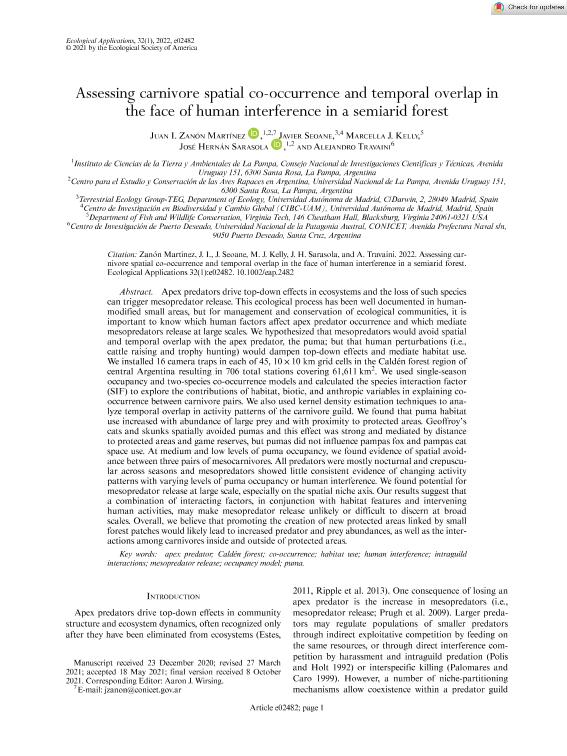Artículo
Assessing carnivore spatial co‐occurrence and temporal overlap in the face of human interference in a semi‐arid forest
Zanón Martínez, Juan Ignacio ; Seoane, Javier; Kelly, Marcella J.; Sarasola, José Hernán
; Seoane, Javier; Kelly, Marcella J.; Sarasola, José Hernán ; Travaini, Alejandro
; Travaini, Alejandro
 ; Seoane, Javier; Kelly, Marcella J.; Sarasola, José Hernán
; Seoane, Javier; Kelly, Marcella J.; Sarasola, José Hernán ; Travaini, Alejandro
; Travaini, Alejandro
Fecha de publicación:
21/10/2021
Editorial:
Ecological Society of America
Revista:
Ecological Applications
ISSN:
1051-0761
e-ISSN:
1939-5582
Idioma:
Inglés
Tipo de recurso:
Artículo publicado
Clasificación temática:
Resumen
Apex predators drive top-down effects in ecosystems and the loss of such species can trigger mesopredator release. This ecological process has been well documented in human-modified small areas, but for management and conservation of ecological communities, it is important to know which human factors affect apex predator occurrence and which mediate mesopredators release at large scales. We hypothesized that mesopredators would avoid spatial and temporal overlap with the apex predator, the puma; but that human perturbations (i.e. cattle raising and trophy hunting) would dampen top-down effects and mediate habitat use. We installed 16 camera traps in each of 45, 10x10-km grid cells in the Caldén forest region of central Argentina resulting in 706 total stations covering 61,611km2. We used single-season occupancy and two-species co-occurrence models and calculated the species interaction factor (SIF) to explore the contributions of habitat, biotic, and anthropic variables in explaining co-occurrence between carnivore pairs. We also used kernel density estimation techniques to analyze temporal overlap in activity patterns of the carnivore guild. We found that puma habitat use increased with abundance of large prey and with proximity to protected areas. Geoffroy´s cats and skunks spatially avoided pumas and this effect was strong and mediated by distance to protected areas and game reserves, but pumas did not influence pampas fox and pampas cat space use. At medium and low levels of puma occupancy, we found evidence of spatial avoidance between 3 pairs of mesocarnivores. All predators were mostly nocturnal and crepuscular across seasons and mesopredators showed little consistent evidence of changing activity patterns with varying levels of puma occupancy or human interference. We found potential for mesopredator release at large scale, especially on the spatial niche axis. Our results suggest that a combination of interacting factors, in conjunction with habitat features and intervening human activities, may make mesopredator release unlikely or difficult to discern at broad scales. Overall, we believe that promoting the creation of new protected areas linked by small forest patches would likely lead to increased predator and prey abundances, as well as the interactions among carnivores inside and outside of protected areas.
Archivos asociados
Licencia
Identificadores
Colecciones
Articulos(SEDE CENTRAL)
Articulos de SEDE CENTRAL
Articulos de SEDE CENTRAL
Citación
Zanón Martínez, Juan Ignacio; Seoane, Javier; Kelly, Marcella J.; Sarasola, José Hernán; Travaini, Alejandro; Assessing carnivore spatial co‐occurrence and temporal overlap in the face of human interference in a semi‐arid forest; Ecological Society of America; Ecological Applications; 32; 1; 21-10-2021; 1-18
Compartir
Altmétricas



